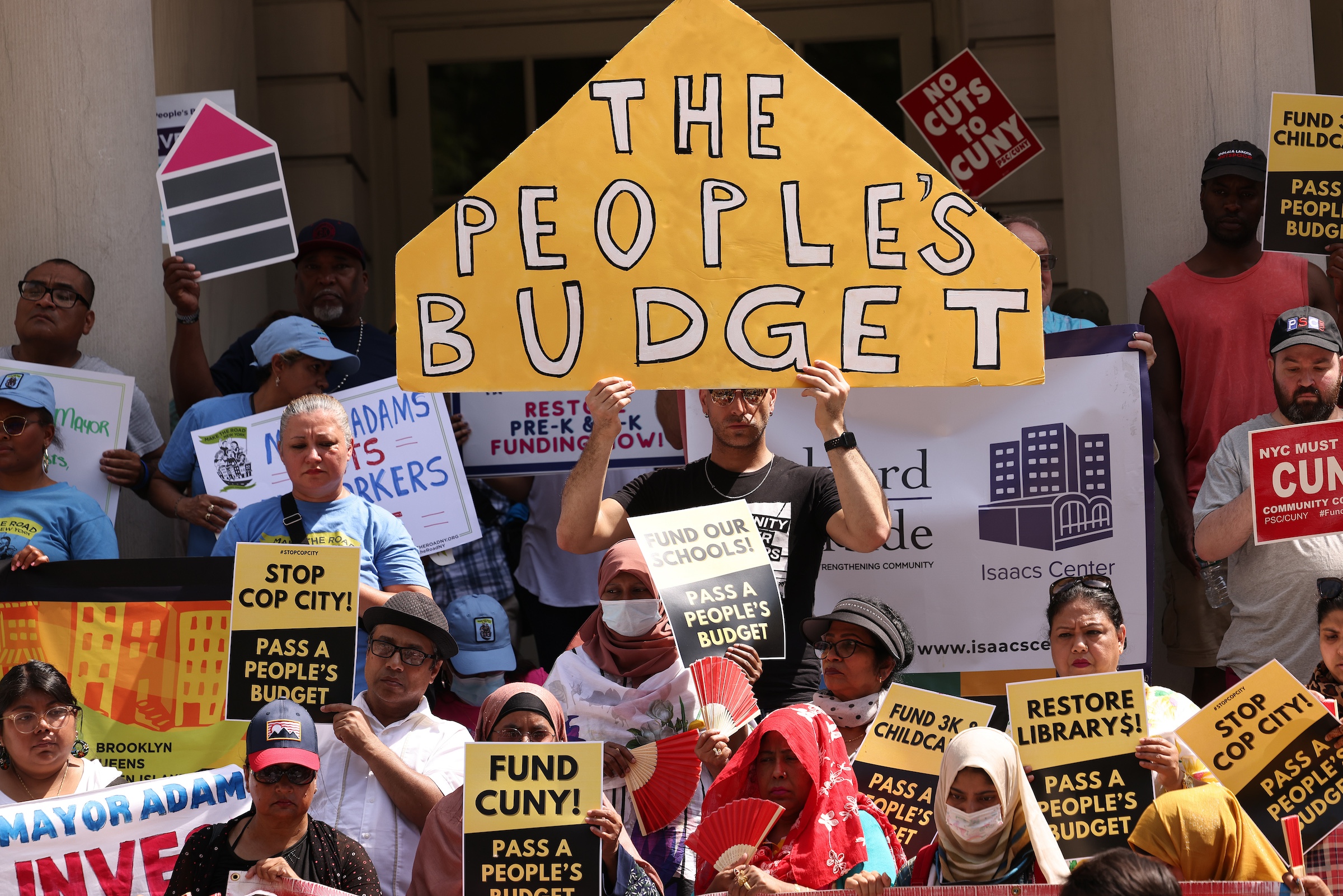
[ad_1]
Mayor Eric Adams and City Council are set to publish New York City’s adopted budget for the 2025 fiscal year by July 1, on the heels of a contentious year of spending cuts that have been met with pushback from institutional leaders, council members, and cultural advocates. The rollbacks have led to reduced programming at cultural institutions such as the Museum of the City of New York, Carnegie Hall, and the Queens Museum, raising concerns for a sector that annually generates over $110 billion in revenue.
In advance of the final budget deadline, city lawmakers made a final effort outside City Hall last week, calling on Adams to devote $53 million to the Department of Cultural Affairs (DCLA) and to restore all expenditure cuts cumulatively impacting the Cultural Institutions Group (CIG) and the Cultural Development Fund (CDF), which doles out grants to more than 1,130 primarily smaller organizations across the city. While the mayor’s office partially restored some of these cuts in April, it did not address cuts from November; cultural advocates are calling for a restoration of these funds ($7.9 million) in addition to $45.1 million on top of the executive baseline budget.
Adams’s proposed executive budget, released on April 24, allocates $151 million to the DCLA. (The finalized budget is expected to be much higher, as it will include city council’s initiatives and negotiated funding, which are not included in the mayor’s executive draft.) City Comptroller Brad Lander noted that the plan affects the 34 institutional members in the CIG and the CDF. The CIG still faces $6.5 million in cuts for the 2025 fiscal year, as well as $6.6 million in reduced funding for each year after; the CDF is also confronting a $1.4 million baselined reduction from the 2025 fiscal year onwards, according to Lander’s report.
Lisa Gold, who heads the Asian American Artists Alliance (A4), told Hyperallergic that despite its 41-year history, the arts organization’s funding “wasn’t spared” from the recent budget rollbacks to the CDF, citing a 5% reduction in this year’s CDF grant award from last year’s.
“Unlike several organizations whose funding was cut entirely, A4 will find a way to make up the difference,” Gold said. “However, this reduction means we can fund 30 fewer artists, who will, in turn, serve between 300 and 15,000 fewer New Yorkers.”
“Due to lasting effects of systemic racism, organizations led by and serving people of color like ours often do not have endowments or a large number of wealthy patrons like predominantly White institutions to make it easier to survive these budget cuts,” Gold added.

The action echoed the demands of a May 10 open letter penned by organizational members of the Cultural Equity Coalition of New York City (CECNY) including LatinX Arts Consortium of NYC (LxNY), A4, Dance/NYC, Indiespace, and A.R.T./New York. The missive has accumulated at least 432 signatures from the city’s arts and cultural workers. CECNY estimated that without the $6.5 million for the CDF, the city’s cultural organizations will lose at least 130 full-time workers and “countless neighborhood art spaces.” Compounding these effects, 3,250 artists will be deprived of opportunities to pursue public projects, CECNY approximates.
Ahead of the budget deadline, on June 27, the Gothamist reported that libraries will see major funding cuts reversed, allowing them to restore seven-day operations. It remains to be seen whether cultural funding at large will be met with good news.
Alongside funding reductions, arts and cultural community members have raised concerns about recent amendments to the CDF, including an adjustment to the current peer panel review which dictates how its grants are allocated. Currently, members of the city’s arts and cultural community who have been recruited by the DCLA score organizations’ CDF applications to determine their grant award size. The new amendment will now allow the department to “adjust awards above the minimum award” and provide grant funding to applicants that “did not meet the minimum award score.”
Some community members have voiced that this amendment could make the grant allocation process more equitable for smaller organizations lacking the resources to compete for city funding.
Lauren Gibbs, a previous panelist for the CDF distribution and current advocate for the nonprofit cultural community, told Hyperallergic that she still has many questions about the purpose of the minimum award changes, given the current panel process already in place.
“I would like to better understand why these changes are being proposed at this time,” Gibbs continued, adding that the changes will only make the peer review process “less democratic and less effective,” instead giving DCLA leaders more power “to make their own award decisions and award adjustments.”
“The nonprofit cultural sector deserves more, not less, openness, transparency, and disclosure regarding these proposed changes to the fund making and scoring allocations before a hasty decision to change the charter is made,” Gibbs said.
[ad_2]